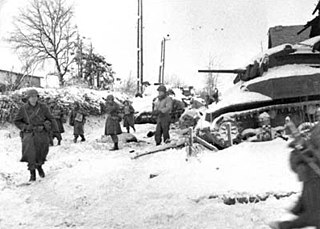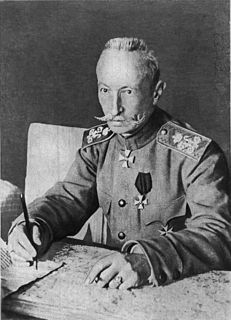
The Battle of the Bulge, also known as the Ardennes Counteroffensive, took place from 16 December 1944 to 25 January 1945, and was the last major German offensive campaign on the Western Front during World War II. It was launched through the densely forested Ardennes region of Wallonia in eastern Belgium, northeast France, and Luxembourg, towards the end of the war in Europe. The offensive was intended to stop Allied use of the Belgian port of Antwerp and to split the Allied lines, allowing the Germans to encircle and destroy four Allied armies and force the Western Allies to negotiate a peace treaty in the Axis powers' favor.

The Battle of the Somme, also known as the Somme Offensive, was a battle of World War I fought by the armies of the British Empire and French Third Republic against the German Empire. It took place between 1 July and 18 November 1916 on both sides of the upper reaches of the River Somme in France. The battle was intended to hasten a victory for the Allies and was the largest battle of the First World War on the Western Front. More than three million men fought in the battle and one million men were wounded or killed, making it one of the bloodiest battles in human history. The Battle of the Somme was fought in the traditional style of World War I battles on the Western Front: trench warfare. The trench warfare gave the Germans an advantage because they dug their trenches deeper than the allied forces which gave them a better line of sight for warfare. The Battle of the Somme also has the distinction of being the first battle fought with tanks. However, the tanks were still in the early stages of development, and as a result, many broke down after maxing out at their top speed of 4 miles per hour.

The Tet Offensive, or officially called The General Offensive and Uprising of Tet Mau Than 1968 by North Vietnam and the Viet Cong, was one of the largest military campaigns of the Vietnam War, launched on January 30, 1968, by forces of the Viet Cong and North Vietnamese People's Army of Vietnam against the forces of the South Vietnamese Army of the Republic of Vietnam, the United States Armed Forces, and their allies. It was a campaign of surprise attacks against military and civilian command and control centers throughout South Vietnam. The name of the offensive comes from the Tết holiday, the Vietnamese New Year, when the first major attacks took place.

The Meuse-Argonne Offensive was a major part of the final Allied offensive of World War I that stretched along the entire Western Front. It was fought from September 26, 1918 until the Armistice of November 11, 1918, a total of 47 days. The Meuse-Argonne Offensive was the largest in United States military history, involving 1.2 million American soldiers. It was one of a series of Allied attacks known as the Hundred Days Offensive, which brought the war to an end. The battle cost 28,000 German lives, 26,277 American lives and an unknown number of French lives. It was the largest and bloodiest operation of World War I for the American Expeditionary Force (AEF) even if, given the scale of other battles on the Western Front, its size was limited and the operation itself secondary as it was far from the main offensive axis. It was the deadliest battle in American history. U.S. losses were exacerbated by the inexperience of many of the troops, the tactics used during the early phases of the operation and the widespread onset of the influenza outbreak called the "Spanish Flu". Meuse-Argonne was the principal engagement of the AEF during World War I.

A running back (RB) is an American and Canadian football position, a member of the offensive backfield. The primary roles of a running back are to receive handoffs from the quarterback for a rushing play, to catch passes from out of the backfield, and to block. There are usually one or two running backs on the field for a given play, depending on the offensive formation. A running back may be a halfback, a wingback or a fullback. A running back will sometimes be called a "feature back" if he is the team's starting running back.

In gridiron football, a lineman is a player who specializes in play at the line of scrimmage. The linemen of the team currently in possession of the ball are the offensive line, while linemen on the opposing team are the defensive line. A number of NFL rules specifically address restrictions and requirements for the offensive line, whose job is to help protect the quarterback from getting sacked for a loss, or worse, fumbling. The defensive line is covered by the same rules that apply to all defensive players. Linemen are usually the largest players on the field in both height and weight, since their positions usually require less running and more strength than skill positions.

The Brusilov Offensive, also known as the "June Advance", of June to September 1916 was the Russian Empire's greatest feat of arms during World War I, and among the most lethal offensives in world history. Historian Graydon Tunstall called the Brusilov Offensive the worst crisis of World War I for Austria-Hungary and the Triple Entente's greatest victory, but it came at a tremendous loss of life.

Operation Bagration was the codename for the Soviet 1944 Belorussian Strategic Offensive Operation, a military campaign fought between 23 June and 19 August 1944 in Soviet Byelorussia in the Eastern Front of World War II. At heavy cost, the Soviet Union inflicted the biggest defeat in German military history by destroying 28 out of 34 divisions of Army Group Centre and completely shattered the German front line.

The tight end (TE) is a position in American football, arena football, and formerly Canadian football, on the offense. The tight end is often seen as a hybrid position with the characteristics and roles of both an offensive lineman and a wide receiver. Like offensive linemen, they are usually lined up on the offensive line and are large enough to be effective blockers. On the other hand, unlike offensive linemen, they are eligible receivers adept enough to warrant a defense's attention when running pass patterns.
Defence in ice hockey is a player position whose primary responsibility is to prevent the opposing team from scoring. They are often referred to as defencemen, defencewomen or defenceplayers, D, D-men or blueliners. They were once called cover-point.
An offensive coordinator is a member of the coaching staff of an American football or Canadian football team who is in charge of the team's offense. Generally, along with the defensive coordinator, he represents the second level of command structure after the head coach. The offensive coordinator is in charge of the team's offensive game plan, and typically calls offensive plays during the game, although some offensive-minded head coaches also handle play-calling. Several position coaches work under the coordinator. The coordinator may also coach a position.

The Hundred Days Offensive was an Allied offensive which ended the First World War. Beginning with the Battle of Amiens on the Western Front, the Allies pushed Central Powers back after their gains from the Spring Offensive. The Germans eventually retreated to the Hindenburg Line, culminating in the Armistice of 11 November 1918. The term "Hundred Days Offensive" does not refer to a battle or strategy, but rather the rapid series of Allied victories against which the German armies had no reply.

In American and Canadian football, a guard (G) is a player who lines up between the center and the tackles on the offensive line of a football team on the line of scrimmage used primarily for blocking. Right guards (RG) is the term for the guards on the right of the offensive line, while left guards (LG) are on the left side. Guards are to the right or left of the center.

In basketball, a rebound, sometimes colloquially referred to as a board, is a statistic awarded to a player who retrieves the ball after a missed field goal or free throw. Rebounds are also given to a player who tips in a missed shot on his team's offensive end. Rebounds in basketball are a routine part in the game, as most possessions change after a shot is successfully made, or the rebound allows the defensive team to take possession. A rebound can be grabbed by either an offensive player or a defensive player.

In American football each team has 11 players on the field at one time. The specific role that a player takes on the field is called their position. Under the modern rules of American football, teams are allowed unlimited substitutions; that is, teams may change any number of players after any play. This has resulted in the development of three "platoons" of players: the offense, the defense, and the special teams. Within those platoons, various specific positions exist depending on what each player's main job is.

Tackle is a playing position in American and Canadian football. Historically, in the one-platoon system prevalent in the late nineteenth and early twentieth centuries, a tackle played on both offense and defense. In the modern system of specialized units, offensive tackle and defensive tackle are separate positions, and the stand-alone term "tackle" refers to the offensive tackle position only. The offensive tackle is a position on the offensive line, left and right. Like other offensive linemen, their job is to block: to physically keep defenders away from the offensive player who has the football and enable him to advance the football and eventually score a touchdown. The term "tackle" is a vestige of an earlier era of football in which the same players played both offense and defense.

A fullback (FB) is a position in the offensive backfield in American and Canadian football, and is one of the two running back positions along with the halfback. Typically, fullbacks are larger than halfbacks and in most offensive schemes their duties are split between power running, pass catching, and blocking for both the quarterback and the other running back.
An offensive is a military operation that seeks through aggressive projection of armed force to occupy territory, gain an objective or achieve some larger strategic, operational, or tactical goal. Another term for an offensive often used by the media is 'invasion', or the more general 'attack'.
Counter-Strike: Global Offensive (CS:GO) is a multiplayer first-person shooter video game developed by Hidden Path Entertainment and Valve Corporation. It is the fourth game in the Counter-Strike series and was released for Microsoft Windows, OS X, Xbox 360, and PlayStation 3 on August 21, 2012, while the Linux version was released in 2014.
















